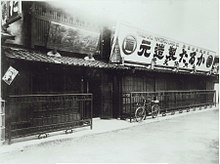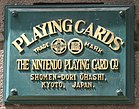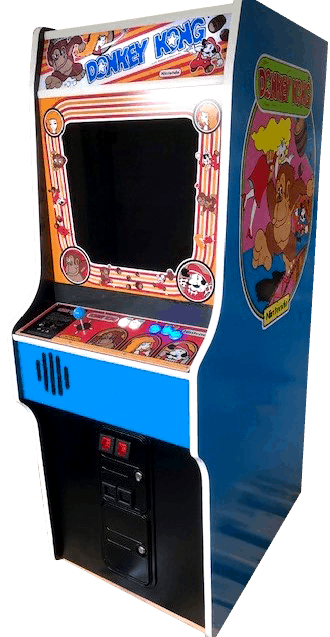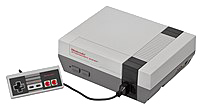History

Nintendo was founded as Nintendo Karuta on 23 September 1889 by craftsman Fusajiro Yamauchi in Shimogyō-ku, Kyoto, Japan, to produce and distribute hanafuda, a Japanese variety of cards. The name Nintendo is commonly assumed to mean 'leave luck to heaven'[9][8]:14, but the assumption lacks historical validation; it can alternatively be translated as "the temple of free hanafuda".[10] With the increase of the cards' popularity, Yamauchi hired assistants to mass-produce to satisfy the demand.[11] Even with a favorable start, the company faced financial struggle due to operating in a niche market, the slow and expensive manufacturing process, high product price, alongside long durability of the cards, which impacted sales due to the low replacement rate.[12] As a solution, Nintendo produced a cheaper and lower-quality line of playing cards, Tengu, while also conducting product offerings in other cities such as Osaka, where card game profits were high. In addition, local merchants were interested in the prospect of a continuous renewal of decks, thus avoiding the suspicions that reusing cards would generate.[13]
According to data from Nintendo, their first western-style deck was put on the market in 1902, although other documents postpone the date to 1907, shortly after the Russo-Japanese War.[14] The war created considerable difficulties for companies in the leisure sector, which were subject to new levies such as the Karuta Zei ("playing cards tax").[15] Nintendo subsisted and, in 1907, entered into an agreement with Nihon Senbai—later known as the Japan Tobacco—to market its cards to various cigarette stores throughout the country.[16]
Japanese culture stipulated that for Nintendo Koppai to continue as a family business after Yamauchi's retirement, Yamauchi had to adopt his son-in-law so that he may take over the business. As result, Sekiryo Kaneda adopted the Yamauchi surname in 1907 and became the second president of Nintendo Koppai in 1929. By that time, Nintendo Koppai was the largest card game company in Japan.[18]

In 1933, Sekiryo Kaneda established the company as a general partnership titled Yamauchi Nintendo & Co. Ltd.,[3] investing in the construction of a new corporate headquarters located next to the original building,[19] near the Toba-kaidō train station.[20] Because Sekiryo's marriage to Yamauchi's daughter produced no male heirs, he planned to adopt his son-in-law Shikanojo Inaba, an artist in the company's employ and the father of his grandson Hiroshi, born in 1927. However, Inaba abandoned his family and the company, so Hiroshi was made Sekiryo's eventual successor.[21]
World War II negatively impacted the company as Japanese authorities prohibited the diffusion of foreign card games, and as the priorities of Japanese society shifted, its interest in recreational activities waned. During this time, Nintendo was partly supported by a financial injection from Hiroshi's wife Michiko Inaba, who came from a wealthy family.[22] In 1947, Sekiryo founded the distribution company Marufuku Co. Ltd.[3]
In 1950, due to Sekiryo's deteriorating health,[23] Hiroshi assumed the presidency of Nintendo. His first actions involved several important changes in the operation of the company: in 1951, he changed the company name to Nintendo Playing Card Co. Ltd.,[3] while the Marufuku Company adopted the name Nintendo Karuta Co. Ltd.[24] In 1952, he centralized the production of cards in the Kyoto factories,[3] which led to the expansion of the offices.[25] The company's new line of plastic cards enjoyed considerable success in Japan.[3] Some of the company's employees, accustomed to a more cautious and conservative leadership, viewed the new measures with concern, and the rising tension led to a call for a strike. However, the measure had no major impact, as Hiroshi resorted to the dismissal of several dissatisfied workers.[26]
In 1959, Nintendo contracted with Walt Disney to incorporate his company's animated characters into the cards.[24] Nintendo also developed a distribution system that allowed it to offer its products in toy stores.[19] By 1961, the company had sold more than 1.5 million card packs and held a high market share, for which it relied on televised advertising campaigns.[27] The need for diversification led the company to list stock on the second section of the Osaka and Kyoto stock exchanges, in addition to becoming a public company and changing its name to Nintendo Co., Ltd. in 1963.[3] In 1964, Nintendo earned an income of ¥150 million.[28]
Although the company was experiencing a period of economic prosperity, the Disney cards and derived products made it dependent on the children's market. The situation was exacerbated by the falling sales of its adult-oriented hanafuda cards caused by Japanese society gravitating toward other hobbies such as pachinko, bowling, and nightly outings.[27] When Disney card sales began to show signs of exhaustion, Nintendo realized that it had no real alternative with which to alleviate the situation.[28] After the 1964 Tokyo Olympics, Nintendo's stock price plummeted to its lowest recorded level of ¥60.[29][30]
Between 1963 and 1968, Yamauchi invested in several business lines for Nintendo that were far from its traditional market and, for the most part, were unsuccessful.[31] Among these ventures were packages of instant rice, a chain of love hotels, and a taxi service named Daiya. Although the taxi service was better received than the previous efforts, Yamauchi rejected this initiative after a series of disagreements with local unions.[32]
Yamauchi's experience with the previous initiatives led him to increase Nintendo's investment in a research and development department directed by Hiroshi Imanishi, an employee with a long history in other areas of the company. In 1969, Gunpei Yokoi joined the department and was responsible for coordinating various projects.[19] Yokoi's experience in manufacturing electronic devices led Yamauchi to put him in charge of the company's games department, and his products would be mass-produced.[33] During this period, Nintendo built a new production plant in Uji City, just outside of Kyoto,[3] and distributed classic tabletop games such as chess, shogi, go, and mahjong, as well as other foreign games under the Nippon Game brand.[34] The company's restructuring preserved a couple of areas dedicated to hanafuda card manufacturing.[35]
The early 1970s represented a watershed moment in Nintendo's history as it released Japan's first electronic toy—the Nintendo Beam Gun, an optoelectronic pistol designed by Masayuki Uemura.[3] In total, more than a million units were sold.[19] During that period, Nintendo began trading on the main section of the Osaka stock exchange and opened a new headquarters.[3] Other popular toys released at the time include the Ultra Hand, the Ultra Machine, the Ultra Scope, and the Love Tester, all designed by Yokoi. The Ultra Hand sold more than 1.2 million units in Japan.[11]

Two key events in Nintendo's history occurred in 1979: its American subsidiary was opened in New York City, and a new department focused on arcade game development was created. In 1980, one of the first handheld video game system, the Game & Watch, was created by Yokoi from the technology used in portable calculators.[3][36] It became one of Nintendo's most successful products, with over 43.4 million units sold worldwide during its production period, and for which 59 games were made in total.[43]
Nintendo's success in arcade games grew in 1981 with the release of Donkey Kong, which was developed by Miyamoto and one of the first video games that allowed the player character to jump.[44] The character, Jumpman, would later become Mario and Nintendo's official mascot. Mario was named after Mario Segale, the landlord of Nintendo's offices in Tukwila, Washington.[45]

In 1983, Nintendo opened a new production facility in Uji and was listed on the first section of the Tokyo Stock Exchange.[3] Uemura, taking inspiration from the ColecoVision,[46] began creating a new video game console that would incorporate a ROM cartridge format for video games as well as both a central processing unit and a physics processing unit.[3][47][48] The Family Computer, or Famicom, was released in Japan in July 1983 along with three games adapted from their original arcade versions: Donkey Kong, Donkey Kong Jr. and Popeye.[49] Its success was such that in 1984, it surpassed the market share held by Sega's SG-1000.[50] At this time, Nintendo adopted a series of guidelines that involved the validation of each game produced for the Famicom before its distribution on the market, agreements with developers to ensure that no Famicom game would be adapted to other consoles within two years of its release, and restricting developers from producing more than five games a year for the Famicom.[51]
In the early 1980s, several video game consoles proliferated in the United States, as well as low-quality games produced by third-party developers,[52] which oversaturated the market and led to the video game crash of 1983.[53] Consequently, a recession hit the American video game industry, whose revenues went from over $3 billion to $100 million between 1983 and 1985.[54] Nintendo's initiative to launch the Famicom in America was also impacted. To differentiate the Famicom from its competitors in America, Nintendo opted to redesign the Famicom as an "entertainment system" compatible with "Game Paks", a euphemism for cartridges, and with a design reminiscent of a VCR.[48] Nintendo implemented a lockout chip in the Game Paks that gave it control on what games were published for the console to avoid the market saturation that occurred in the United States' market.[55] The resulting product was the Nintendo Entertainment System, or NES, which was released in North America in 1985.[3] The landmark titles Super Mario Bros. and The Legend of Zelda were produced for the console by Miyamoto and Takashi Tezuka. The work of composer Koji Kondo for both games reinforced the idea that musical themes could act as a complement to game mechanics rather than simply a miscellaneous element.[56] Production of the NES lasted until 1995,[57] and production of the Famicom lasted until 2003.[58] In total, around 62 million Famicom and NES consoles were sold worldwide.[59] During this period, Nintendo created a measure against piracy of its video games in the form of the Official Nintendo Seal of Quality, a seal that was added to their products so that customers may recognize their authenticity in the market.[60] By this time, Nintendo's network of electronic suppliers had extended to around thirty companies, among which were Ricoh—Nintendo's main source for semiconductors—and the Sharp Corporation.[19]